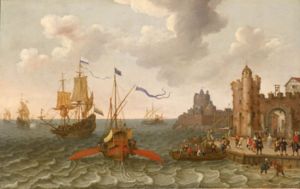
The reasons that European countries and former colonies have certain advantages over under developed countries in the present day world seem to stem from the middle ages and the act of exploration (by advantages I mean technological that lead to a developed country). The inhabitants of Asia, Africa, and the Americas were not the ones exploring, it was solely the Europeans (Adas, 2.) Exploration led to greater wealth, land territory, and innovation. But in this paper I will focus on what led to exploration. Technology enables exploration, but the beginnings of exploration facilitated more technological advancements. A western European of the Middle Ages, Hugh of St. Victor, said, "Propter neressitatem inventa est mechanica”, necessity is the mother of technology. The necessities of western Europeans were found abroad, unlike the necessities of China and other countries.
Before the Middle Ages in Europe ancient Greek and Roman civilizations explored but only in close proximity to the Mediterranean. They did not have the technology to explore farther. They were able to sail and conquer Egypt in their galleys but not the Americas (Why did the Ancients...) By realizing why the age of exploration did not occur before the Middle Ages we could find what directed later cultures towards exploration.
Marxists believe that ancient civilizations did not develop technology because they had slaves to do manual work. Slaves and an excess of non-free labor made technology unnecessary. But there is archeological proof that technology was made in ancient times but scarcely used. Lynn White makes a point that religion is the major cultural difference that inhibited the Greeks and Romans from technology for sea exploration and led northern Europe to their future. The premise of his argument is that the spiritual direction in eastern Greek Christianity was that of “sin is ignorance and that salvation comes by illumination,” while in western Latin Christianity “sin is vice and that rebirth comes by displacing the will to do good works.” In western practices, technology was praised as a Christian virtue. Monks went into raptures about technologies that embellished their religious lives and aided in secular activities. The reason for the difference in religious views is a consequence of the advancement of cultures. In the east, civilizations were more adapt and monks were not needed to act on secular issues like they were in the west (Why did the Ancients not…) In the Far East, China already had massive naval fleets and ships that could sail around the world (Teresi, 367.) They invented technologies that Europeans would later use to sail around the world. And yet, they did not explore to the degree Europeans did. Although there is religious reasons for this (Shaffer) the most powerful and obvious rationale for this seems to be necessity. The Chinese had everything they needed where they were. They traveled to the Spice Islands, but they weren’t that far (Shaffer.) They had no need to trade with European nations because they could manufacture everything they needed at home (Terisi, 367.)
The Mediterraneans and Chinese had the resources they needed, while the northern Europeans did not. They had to trade with the Meditteraneans to acquire spices and gold or find their own route to the Spice Islands. Northern European culture was already on track for technological advancements because of religious issues so the necessity of resources aided in the further development of technology. As Epilogue says, “Religion supplied the pretext and gold the motive.”
The gunned ship was the technology that enabled Atlantic Europe’s domination of the oceans and exploration (Cipolla.) “Sailing ships with superior maneuverability and armament permitted the Europeans to explore, trade, and conquer all around the world” (Adas, 2.) As Europe continued to increase their technological advancements of shipbuilding and ship warfare other areas had a hard time keeping up. An example of this is the broadside canon and later the notion of ship-of-the-line tactics. The broadside cannon was first used in Atlantic coast countries but spread to the Mediterranean through battles in the 16 th century. In 1571 a Christian fleet of broadside ships showed the Turks that oar ships were a way of the past. This defeat made the Turks advance their technology (Andres and Goldman.) The ship-of-the-line tactics invented by the English used between the 16 th and 19 th centuries were used to bring the greatest weight of broadship guns to stand in a battle. This technology spread quickly to other Atlantic countries but slowly to the Mediterranean area because of the scale of the ships. The ships worked well in the wide ocean, and eventually led to ocean domination by the Europeans (Cipolla), but could not maneuver well in the Mediterranean (Andres and Goldman.) The geographic location of the Ottoman Empire disabled them from keeping up with the technology in Atlantic Europe but also their slowness in adapting and inventing new technologies eventually led to their conquering. “It [invention of gunned-ships] further enlarged the military technological gap between Europe and the rest of the world and the balance of world power became more unbalanced than ever. As with naval artillery and sailing ships, the Europeans rapidly improved upon their new discovery before the non-Europeans were able to absorb it” (Adas, 144.)
The continual advancement of technology in Europe combined with necessity gave them the advantage of exploration. T he exploration culture of Northern Europe then led to technological advances in shipbuilding, cartography, navigation, and firepower, for exploration purposes. The examples of broadside cannon ships and ship-of-the-line tactics serve to show that as Europeans explored more their need for innovative technology increased.